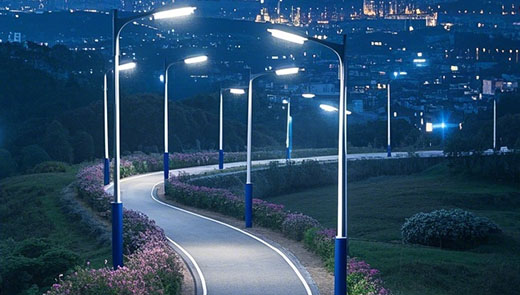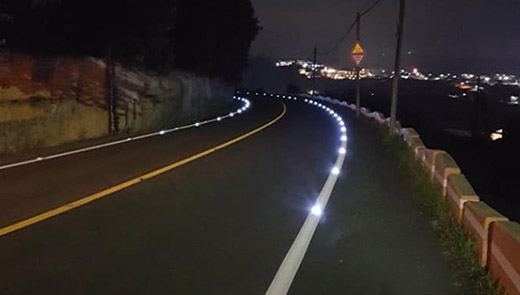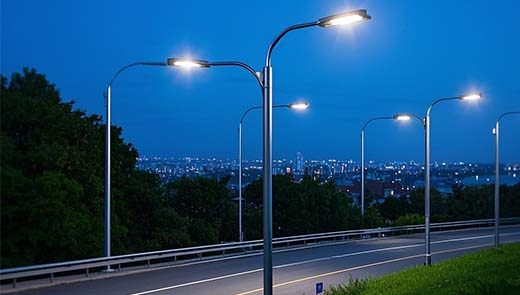How to Choose Light Pole of Solar Led Street Light?
In the overall planning and implementation of a solar LED street light project, the choice of light pole is by no means an arbitrary decision, but plays a decisive role in the success of the project. The right pole can not only guarantee efficient lighting, ensure the safety of pedestrians and vehicles at night, extend the service life of the street light, reduce the maintenance cost, but also optimize the cost of the project as a whole. Whether it is large-scale urban street lighting to create a prosperous city at night, or small community lighting projects to create a warm and comfortable living environment, the choice of light poles are directly related to the final results of the project.
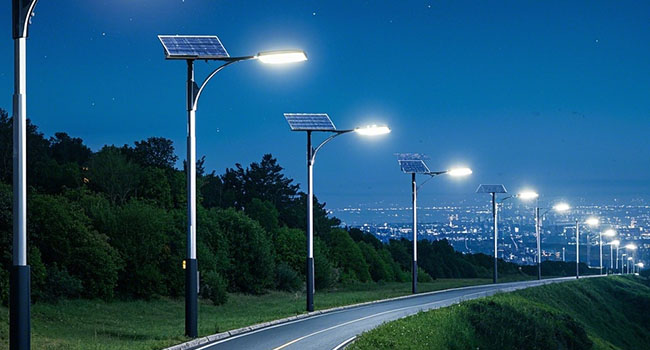
What is a solar street light pole?
The solar street light pole occupies a central position in the whole solar street light system. It is like a solid guardian, bearing the heavy responsibility of fixing the key components, including the lighting module, solar panel, rechargeable battery storage module and electronic control device. These components are the organs of the human body, and the pole is the skeleton that holds them all together.
The way the pole fixes the other components is not fixed, but depends on the type of solar street light and the specific application scenario. For example, in some scenic spots with high requirements for aesthetics, solar street lights with integrated design may be used, and the shape and fixing method of the light pole will pay more attention to the integration with the surrounding environment; while in industrial areas, more emphasis is placed on the utility and carrying capacity of the light pole, and the fixing method will be more inclined to be firm and stable.
Like most traditional street lights, solar street light poles are usually installed on a solid reinforced concrete foundation. This kind of foundation is like a “sea pin” for the light pole, which can provide stable support for the pole to ensure that it can still stand and work normally in front of various complicated environmental conditions, such as strong winds, heavy rains, earthquakes and other natural disasters. The design and construction of reinforced concrete foundation need to strictly follow the relevant standards and norms to ensure that its bearing capacity and stability meet the requirements.
Different types of solar street light poles
Single-arm street light poles vs Double-arm poles
The arm is an important structure of the solar street light, which extends outward from the top of the vertically mounted pole to the top of the road, like an extended arm, used to fix the lighting module and illuminate the area below.A single arm street light pole, which can be visualized from its name, can only hold one LED module. This kind of pole is usually installed on one side of the one-way or two-way road, applicable to the narrower road width, lighting demand is relatively low scene. For example, some of the roads within the community, rural trails, etc., single-arm street light poles can meet the lighting needs, but does not cause a waste of resources.
Double-arm street light pole, on the other hand, can fix two lighting modules, usually installed in the middle of the two-way road. It is like an impartial referee, which can provide symmetrical lighting for both sides of the road at the same time, ensuring that every corner of the road is evenly illuminated. Double arm street light poles are widely used in places with high traffic and pedestrian flow, such as main roads and commercial streets in cities, to provide sufficient lighting and ensure traffic safety.
Split street light pole and integrated street light pole
In the common integrated solar street light, LED lighting, solar panels and batteries are integrated into a unified module, which means the arm carries all the components of the street light. The advantages of this design are easy installation, overall aesthetics, and reduced connecting lines between components, reducing the probability of failure. It is suitable for places that require high installation speed and aesthetics, such as parks and squares.

In contrast, early street lights, including split solar street lights and two-split street lights, have separate lighting modules and solar panels. The solar panel is mounted on the top of the pole through a split arm structure or suspended from the side of the pole with the help of fittings. The advantage of this design is that the position of the solar panel and the lighting module can be flexibly adjusted according to the actual demand, in order to obtain better light effect and lighting range. However, the disadvantage is that the installation process is relatively complicated, requiring more connection lines and increasing the difficulty of maintenance.
Steel solar street light pole and aluminum street light pole
Solar street light poles are made of a rich variety of materials. Nowadays, concrete poles are less common in the street light field, and most street light poles are made of steel or aluminum. Below is a comparison of steel and aluminum light poles in several ways:
|
Feature |
Steel Light Pole |
Aluminum Light Pole |
|
Rigidity |
Higher |
Relatively lower |
|
Strength-to-Weight Ratio |
High |
High, but differs from steel |
|
Corrosion Resistance |
Average, requires anti-corrosion treatment |
Better |
|
Maximum Height |
Higher |
Relatively limited |
|
Processing Difficulty |
Varies by material |
Relatively easy |
|
Price |
Generally more economical |
Usually more expensive |
A number of factors, such as installation and climatic conditions, project budgets, and lighting requirements, can directly or indirectly affect the choice of light pole material. For example, in coastal areas, due to the high salt content in the air, the corrosion resistance of the light poles is required, aluminum light poles may be a better choice; while in projects with limited budgets, steel light poles are preferred by virtue of their affordability.
Commercial and industrial street light poles and residential street light poles
Over the decades, solar street lights have expanded their applications and are no longer limited to the transportation sector. Many solar street lights are designed specifically for commercial and residential use, commonly found on factory park roads or near garden fences.
Requirements for street lights in commercial and industrial locations usually focus more on lighting brightness and coverage to meet production and logistics needs. As a result, industrial and commercial streetlight poles are generally taller and have a higher load-bearing capacity, enabling the installation of higher-powered lighting equipment. At the same time, in order to adapt to the complexity of the industrial environment, industrial and commercial street light poles will emphasize more on durability and stability in terms of material and structure.
Residential street light poles, on the other hand, pay more attention to creating a warm, comfortable living atmosphere, lighting brightness is relatively moderate, not too harsh. In terms of appearance design, residential street light poles will pay more attention to the coordination with the surrounding environment, and may adopt some unique shapes and soft color designs to increase the beauty of the community.
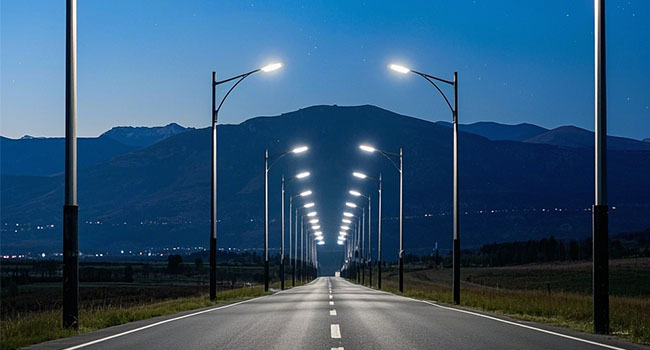
Functional street light poles and decorative street light poles
Modern street light projects, in addition to the requirement for street light poles to have the basic function of fixing and carrying parts, the demand for their aesthetics is also increasing. The transportation system is a window to display the city's image and characteristics, and as a fundamental part of street lighting, the pole now also assumes the role of a promotional medium.
Many street lighting projects will customize the poles so that they echo the city's visual identity system in terms of theme colors, patterns or elements. For example, in some historical and cultural cities, the design of the light poles may incorporate local traditional architectural styles and cultural elements, such as carvings and colorful paintings, to show the city's historical heritage; while in some modernized cities, the design of the light poles may be more simple and stylish, with smooth lines and vibrant colors, reflecting the city's vitality and innovation.
The value created by these decorative solar street light poles far exceeds their cost, promoting the energy transition and green development of the city as well as enhancing the city's popularity. They are like the city's business card, attracting the attention of tourists and investors and injecting new vitality into the city's development.
Determine the right height for solar street light poles
Road width
The wider the road, the higher the pole needs to be in order to provide adequate lighting and maximum coverage. The height of the pole will vary depending on the type of distribution of the street light:
Unilateral distribution: the height of the streetlight pole should be equal to or higher than the width of the roadway. For street lights with wider beam angles, the pole height can be less than the road width, calculated as: pole height = road width ÷ (1.1 - 1.3). This is because a wider beam angle can be achieved at a lower pole height to achieve a greater range of lighting, through reasonable calculation and design, can ensure that the lighting effect at the same time, reduce costs.Bilateral symmetrical distribution: The height of bilateral symmetrical street lamps is equal to half of the width of the road. This distribution can make the lighting on both sides of the road uniform, avoiding uneven brightness and darkness, and providing a good visual environment for pedestrians and vehicles.
Double-sided staggered distribution: The height of double-sided staggered distribution of street lamps should be at least 70% of the width of the road in order to achieve the best lighting effect. Through staggered distribution and appropriate height setting, the blind spot of lighting can be effectively eliminated and the safety of the road can be improved.
Type of lighting required
If there is a high demand for illumination, such as streets with heavy traffic or pedestrian activities, higher poles may be required to provide sufficient light. Generally speaking, 3 - 4 meters high light poles are suitable for walking paths, at which height they can provide sufficient lighting for pedestrians without causing a sense of oppression; 5 - 7 meters high solar street light poles are suitable for two-lane rural roads to meet the lighting needs of rural traffic; 8 - 10 meters high solar street light poles are suitable for three-lane or two-way four-lane main roads to ensure that the illumination of the city's main road brightness and coverage.
Height of other nearby objects
Another important factor to consider is the height of other nearby objects. If there are tall buildings or trees nearby, it may be necessary to raise the height of the light poles to ensure that the light is not blocked. For example, in some older neighborhoods with heavy trees around, a taller pole will need to be chosen to ensure that the street lights are effective in illuminating the road so that the light can get past the trees and illuminate the road.
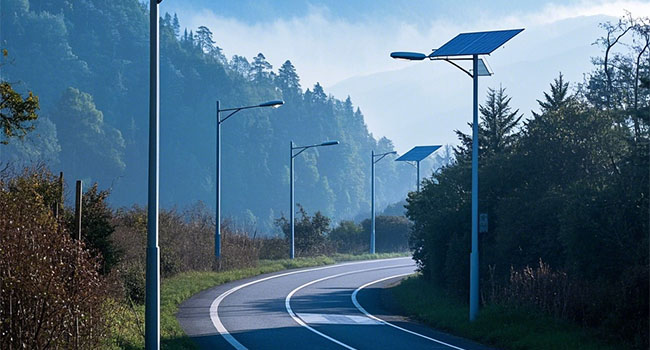
Requirements of light pole materials
At present, the most common solar street light pole material is Q230 rolled steel. Because of the poor corrosion resistance of this material itself, it is susceptible to erosion by oxygen, moisture and other corrosive substances in the air during long-term use, resulting in rust and damage. Therefore, its surface needs to be galvanized to enhance the corrosion resistance of the light poles, and common galvanizing methods include cold galvanizing and hot-dip galvanizing.
Cold galvanizing is the electro-chemical plating of zinc on the surface of steel to form a protective film. This method is simple and low cost, but the galvanized layer is thin and the corrosion resistance is relatively weak. Hot-dip galvanizing, on the other hand, involves immersing the steel in a molten zinc solution so that the zinc reacts chemically with the surface of the steel to form a thicker galvanized layer. Compared with cold galvanizing, hot-dip galvanized light poles have better anti-corrosion properties and can be used for a long time in harsh environments. Therefore, when shopping, it is recommended to give preference to light poles that have been hot-dip galvanized.
In addition, some common solar street light poles use stainless steel or anodized aluminum as the surface material, both of which also have excellent corrosion resistance and can maintain good performance in various environments. Stainless steel has the advantages of high strength, abrasion resistance, corrosion resistance, etc., but the cost is relatively high; anodized aluminum has the characteristics of lightweight, beautiful, corrosion resistance, etc., but its processing process is more complex, which also leads to a higher cost. Users can make a choice according to their own budget and actual needs.
Choose the right solar street light pole wall thickness
The wall thickness of the light pole is another important factor in determining its strength and durability. The thicker the wall thickness, the stronger the pole will be. Usually, thick-walled poles have enough wind resistance and load-bearing capacity to ensure the safe operation of the street light under adverse weather conditions. However, thick wall will also increase the manufacturing cost of the pole, not only the cost of raw materials will increase, the processing difficulty and energy consumption will also increase accordingly.
Therefore, when choosing the wall thickness of solar street light poles, you need to weigh between strength and cost. Generally speaking, for installation environments with less wind, thinner poles can be used to reduce costs; while in open areas with higher winds, such as seashores and hilltops, thicker poles need to be used in order to ensure the stability of the poles. Ultimately, the choice of wall thickness of the light pole depends on the specific installation scenario requirements.Typically, different heights of light poles correspond to the following wall thickness requirements:
|
Light Pole Height |
Recommended Wall Thickness |
|
2 - 4 meters |
2.5 mm and above |
|
4 - 7 meters |
3 mm |
|
8 - 9 meters |
3.25 - 3.5 mm |
|
10 - 12 meters |
3.75 - 4 mm |
In areas where there are often strong winds, or when heavier lead-acid gel batteries are fixed on the top of the pole, the external force on the pole will increase, and the wall thickness of the pole needs to be increased appropriately in order to ensure the safety of the pole. For example, in coastal areas, which are often affected by typhoons, the wall thickness of the light pole may need to be increased by 0.5 - 1 millimeter compared with ordinary areas in order to improve the wind resistance of the light pole.
When selecting a solar street light pole, a number of factors such as pole type, height, material and wall thickness need to be considered. Each project has its unique needs, from the budget of the project, the characteristics of the installation environment, to the requirements for lighting effect and aesthetics, all of which need to be analyzed comprehensively. Only in this way can we make the most appropriate choice to create an efficient, durable and aesthetically pleasing solar street light system that brings light and convenience to people's lives and the development of the city.

